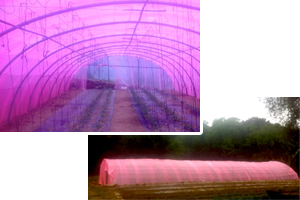Sunlight Spectrum Modification: Difference between revisions
(Created page with "thumb|300px|Example of greenhouse cover with additive to that changes the spectral composition of sunlight to optimize crop yields. With th...") |
No edit summary |
||
| Line 1: | Line 1: | ||
[[Image:PhotofuelGreenhouse.jpg|thumb|300px|Example of greenhouse | [[Image:PhotofuelGreenhouse.jpg|thumb|300px|Example of greenhouse with an additive to the cover film, so that the spectral composition of sunlight is modified in order to optimize crop yields. ]] | ||
With this technology, certain pigments are embedded in greenhouse films, in order to shift the wavelength of the incoming sunlight to better match crop preferences (i.e. towards red). This can lead to improved crop yields. | With this technology, certain pigments are embedded in greenhouse films, in order to shift the wavelength of the incoming sunlight to better match crop preferences (i.e. towards red). This can lead to improved crop yields. | ||
Revision as of 13:57, 1 September 2016
With this technology, certain pigments are embedded in greenhouse films, in order to shift the wavelength of the incoming sunlight to better match crop preferences (i.e. towards red). This can lead to improved crop yields.
“The technology we use actually involves no filtering,” explained PhotoFuel's chief scientific officer Timmy Floume. “What we do is shift wavelengths to modify the sunlight spectrum reaching the plants.” They work with photoluminescent plastic to shift light wavelengths to provide the optimal conditions for a variety of settings. For greenhouses, where plants thrive under red light and reflect away unused green light, the goal is to change green light into the red light that plants crave. That extra energy benefits plants, and the increased yields benefit growers. “
Patent Situation
(insert results of patent search here)
Relevant Links
- Article on Hortidaily: “Photoluminescent plastic shifts sunlight to increase crop yields”
